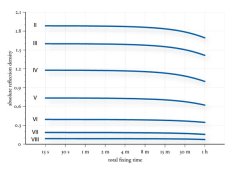The Dilution Changes Now and Then
Ah, yes! I bought a 1l bottle yesterday and noticed the same thing,
but have a closer look and you'll see that this is for the 1+3 dilution,
even less diluted than the 1+4 they proposed until now.
I've a reference from 1981 pegging the dilution a 1:3. I just checked
Ilford's on line PDF dated 2002 which pegs the dilution at 1:4. And
now on the bottle you say 1:3.
I also noticed that the ingredients listed on the label have changed
somewhat. Older bottles listed sodium acetate, sulfite and bisulfite,
ammonium thiosufate and water. The new bottle has acetic acid,
sodium sulfite, water, ammonium thiosulfate.
It adds up to the same or very nearly the same fixer. The older
mix had as an acid component bisulfite. Sodium acetate is the
sodium salt of acidic acid and is alkaline. The newer mix has
the acid and counters it with the alkaline sodium sulfite.
Likely more of the sulfite is added. Both have the
same mix of ions although the blend may have
been modified some little.
Regarding how much time a print needs in the fixing bath,
follow the papers manufacturer's times for paper strength fixer
(for a rapid one), but do check with selenium toner to be sure.
There's no substitute for real evidence and FB prints can be
archival only if they're treated accordingly!
Paper Strength for paper. Film strength, which some use, was
a popularized Ilford invention from the early 1980s and the
fixer step of the Ilford Archival Sequence. The other steps
are a first wash, a protracted soak in wash aid, then
a second wash. All in all, the quickest way to
a clean print.
Ilford PDFs no longer make any mention of the sequence. They
do though still note a paper time for Film strength.
Two Bath: Ilford "... extremely efficient ..." Dan




